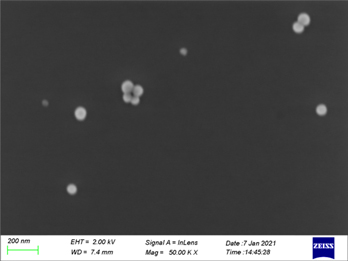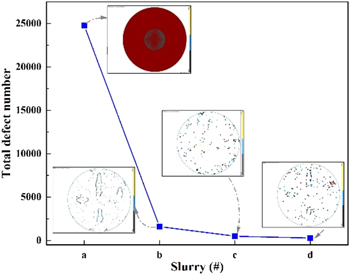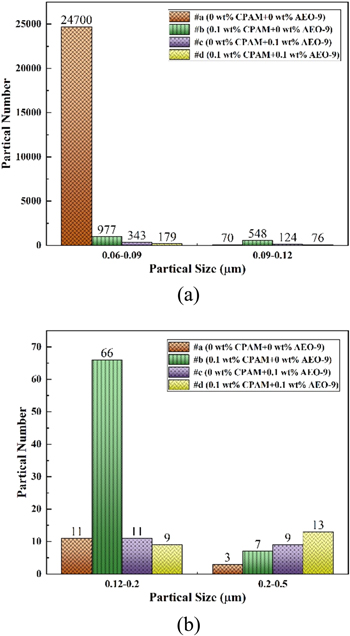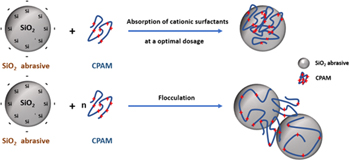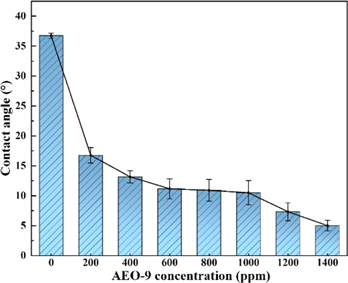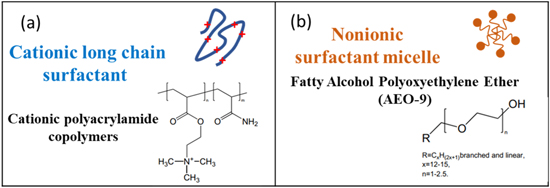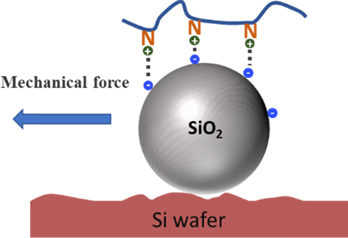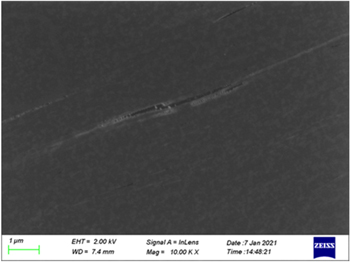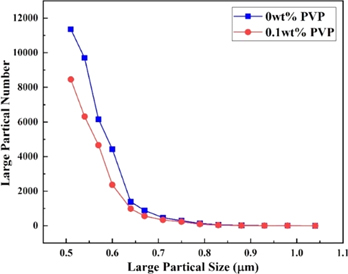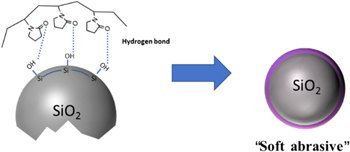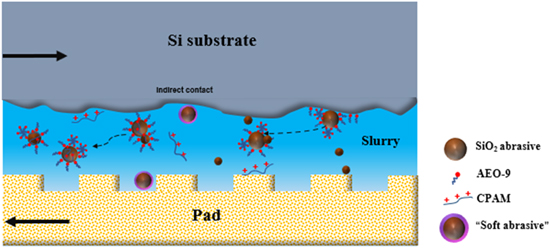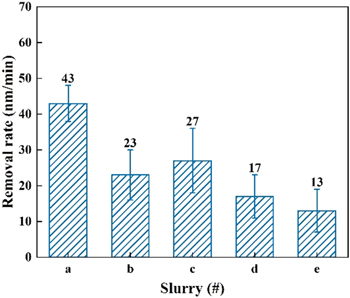Abstract
The final polishing of silicon results in the irresistible formation of micro-defects (i.e., particle residues and scratches) on the surface. In view of this problem, the synergistic effect of surfactants and water-soluble polymers in inhibiting the micro-defects on the silicon surface was studied in this paper to improve the wettability of the slurry and reduce the micro-flocculation of abrasive particles. The results showed that the total number of residual particles (≥0.06 μm) on the polished surface was reduced from 24,784 to 277 with the adsorption of cationic polyacrylamide (CPAM) and fatty alcohol polyoxyethylene ether (AEO-9). The water-soluble polyvinylpyrrolidone (PVP) polymer could coat on the SiO2 abrasives, inhibit the flocculation of abrasive particles, avoid scratches on the silicon surface and further reduce the number of residual particles (≥0.06 μm) to 67 on the polished surface. Furthermore, a contact angle analyzer was used to characterize the wettability of the components in the slurry, and a large particle counter was used to analyze the changes in the number of large particles in the slurry component. Finally, a mechanism of surfactants and a water-soluble polymer combined system was proposed to suppress the micro-defects on the surface of the silicon wafer.
Export citation and abstract BibTeX RIS

This is an open access article distributed under the terms of the Creative Commons Attribution Non-Commercial No Derivatives 4.0 License (CC BY-NC-ND, http://creativecommons.org/licenses/by-nc-nd/4.0/), which permits non-commercial reuse, distribution, and reproduction in any medium, provided the original work is not changed in any way and is properly cited. For permission for commercial reuse, please email: permissions@ioppublishing.org.
Being a major element of contemporary electronic information technology, the integrated circuit manufacturing process promotes the development of the world economy and information technology. Meanwhile, the silicon wafer is a substrate material widely used in semiconductor and optical devices industries due to its excellent mechanical and chemical properties. 1–3 In the manufacture of semiconductor devices, chemical-mechanical polishing (CMP) is the unique key technology feasible for surface flattening and realization of local and global planarization. 4–6 To further improve the surface morphology of the silicon substrate and satisfy the decreasing processing technology nodes, the CMP of the silicon substrate is mainly conducted in two steps: stock polishing and final polishing. Stock polishing helps in the rapid removal of the damaged layer of the surface, while final polishing is essentially a polishing and washing process for the rapid stripping and correction of residual particles and scratches on the surface subjected to stock polishing that reduces its roughness.
Due to their complex molecular structures and properties, water-soluble organic compounds are often used as lubricants, wetting agents, and "corrosion inhibitors" to control the number of residual micro-defects on the surface of the wafer subjected to final polishing. Xu et al. 7 found that AEO molecules can be effectively adsorbed between abrasive particles and polished wafer surface to form an adsorption layer and protect the surface from chemical and mechanical erosion. Hong et al. 8 prepared α-alumina-g-PAM composite abrasives by surface grafting polymerization and studied the chemical mechanical polishing performance of composite abrasives on glass substrates. The authors found that the composite abrasive had better dispersion than pure α -alumina abrasive. Under the same polishing conditions, the composite abrasive slurry has low surface roughness, small morphological changes, few scratches, and shallow scratches. Li et al. 9 studied the effect of additives in chemical mechanical polishing of silica film with silica sol-based slurry. It is considered that the COO− chain produced by PAM hydrolysis weakens the attraction between the abrasives and improves the stability of the slurry. Yang et al. 10 proposed biocompatible PVP instead of traditional BTA, and found that PVP has a better inhibitory effect than BTA as an inhibitor, but did not explain the adsorption mechanism of PVP on the Cu film layer surface.
In addition, the surfactant mixtures systems, especially mixed with nonionic surfactants, have been widely used in various industries and agriculture because of their better application performance than single surfactants. 11 Gong et al. 12 used aminopropyltriethoxysilane (APTES) and polyoxyethylene (PEO) to modify abrasives. The experiments found that modified abrasives can achieve better surface quality. Compared with PEO, APTES modified abrasives can obtain lower surface roughness (Ra = 0.054 nm). Li et al. 13 introduced polyoxyethylene ether and HEC. Polyoxyethylene ether can be combined with SiO2 abrasive to form a "soft-coating" abrasive. HEC formed a hydration layer on the surface of the wafer and played the role of "micro-lubrication." The Haze value is reduced to 0.01 ppm, and the surface morphology is greatly improved. Tang et al. 14 studied the synergistic removal effect of an alkaline chelating agent (FA/O Ⅱ) and AEO surfactant on benzotriazole (BTA) in the post-CMP cleaning process. The author believed that AEO-9 had strong permeability, which could be permeated between Cu-BTA residue and Cu surface to improve the cleaning effect.
In this study, two surfactants were used to test their impacts on the number of residual particles on a silicon surface after final polishing, which were further combined with a water-soluble polymer to effectively control the micro-scratches on the surface so as to significantly reduce the number of micro-defects on the surface by virtue of the synergistic effect. The results showed the AEO-9 molecules to be a strong penetrating agent that was adsorbed on the surface of the silicon wafer and interfered with the adhesion of the abrasive particles on the surface, further reducing the particle contamination on the surface under the electrostatic force between the cationic polyacrylamide (CPAM) and SiO2 particles. Based on these analyses, a possible mechanism was proposed for the adsorption of the surfactants and water-soluble polymer on abrasives and the silicon wafer to reduce the number of micro-defects in the final polished.
Experimental
Components and preparation of the slurry
The PL-3 silica sol produced by the FUSO Chemical Co., Ltd. was selected as the abrasive for the polishing process in this experiment. In order to better understand the impact of the two surfactants and water-soluble polymer on the residual particles on the surface subjected to final polishing, five types of slurry (a, b, c, d, and e) were prepared to perform comparative experiments, with the components and corresponding proportions listed in Table I. The raw materials were used without further purification in the study. The SiO2 sol, deionized water, surfactants (CPAM and AEO-9), water-soluble polymer (PVP), and tetramethylammonium hydroxide (TMAH) were slowly mixed and then stirred for 10 min by a magnetic stirrer at a rotating speed of 120 rpm. The prepared slurry was filtered through a 1 μm filter element produced by the American Membrane Corporation (AMC).
Table I. Components of the slurry (a)–(e) and the corresponding proportions.
| Proportion | |||||
|---|---|---|---|---|---|
| Component | a (wt%) | b (wt%) | c (wt%) | d (wt%) | e (wt%) |
| Silica sol | 2 | 2 | 2 | 2 | 2 |
| TMAH | 0.1 | 0.1 | 0.1 | 0.1 | 0.1 |
| CPAM | 0 | 0.1 | 0 | 0.1 | 0.1 |
| AEO-9 | 0 | 0 | 0.1 | 0.1 | 0.1 |
| PVP | 0 | 0 | 0 | 0 | 0.1 |
Polishing experiment
In this experiment, a 12-inch silicon wafer (100) with a diameter of 300 mm was selected and polished on a Politex polishing pad (Rohm and Haas Co. Ltd.) using the universal-300 polishing machine (HWATSING Co., Ltd.), it has a built-in cleaning module for cleaning. The key polishing parameters are listed in Table II.
Table II. Key polishing parameters.
| Polishing parameter | Conditions |
|---|---|
| Pressure | 1.5 psi |
| Volume flow rate | 300 ml min−1 |
| Polishing speed (Head/Platen) | 60/60 rpm |
| Polishing time | 60 s for slurry polishing +30 s for water polishing +60 s for slurry polishing |
CMP performance characterization
An SP2 global defect detection system sourced from Applied Materials, Inc. (AMAT) was used to detect the types and number of defects on the surface. The numbers of defects with different sizes and global distribution of the defects were also obtained. A 5600LS atomic force microscope (AFM) produced by Agilent was used for the detection of the morphology and roughness of the surface before and after final polishing within a scope of 10 μm × 10 μm. Also, the scanning electron microscope (SEM) was used to characterize the micromorphology of the defects on the polished wafer surface. Further, the contact angle analyzer (JD200D, Shanghai Zhongchen) was used to place 12.5 μl of slurry on the silicon wafer surface. After 10 s, the picture of the surface was taken to measure the contact angle between the slurry and the wafer surface. The number of large particles in the slurry was counted using the Accusizer-780-APS produced by the PSS in the United States to observe their variation.
Results and Discussion
Effect of surfactants on the number of surface micro-defects
According to the theory of Brownian motion, the abrasive particles show irregular motion between the polishing interfaces. Meanwhile, the surface energy of the polished silicon wafer was very high that the SiO2 sol easily formed flocculation and residue on the wafer surface (Fig. 1). In this circumstance, the surfactant can be used to weaken the adhesion of the abrasive particles on the wafer as adsorbed on the surface of the abrasives to form a self-assembled layer. 15–17 In this experiment, SP2 was used to detect any defects on the silicon wafer surfaces after final polishing with four types of slurry (a, b, c, d), respectively. Figure 2 shows the impact of different surfactants on the total number of micro-defects on the surface. It was revealed that the addition of surfactant posed a prominent influence on the residual number of silica sol particles. When no surfactant was added to the slurry, the total number of residual particles (greater than 0.06 μm) on the surface was 24,784. Upon the addition of 0.1 wt% CPAM to the slurry, the number of residual particles was reduced to 1,598. When AEO-9 was added to the slurry, the number was further reduced to 487. Furthermore, the number of residual particles was reduced to 277 on the addition of both CPAM and AEO-9 to the slurry.
Figure 1. Morphology of residual particles on the silicon wafer after final polishing.
Download figure:
Standard image High-resolution imageFigure 2. Effect of total defect number with four different slurries on Si final polishing.
Download figure:
Standard image High-resolution imageFigure 3 demonstrates the specific distribution of 0.06–0.5 μm micro-defects on a silicon surface subjected to final polishing. It was observed from Fig. 3a that the number of 0.06–0.09 μm residual particles were significantly reduced by the addition of CPAM/AEO-9. Compared to CPAM, AEO-9 was more effective in the removal of 0.06–0.09 μm residual particles on the surface after polishing. Meanwhile, the number of 0.06–0.09 μm defects on the global wafer surface were reduced to 179 upon the addition of the combination of the two types of surfactants. It was discovered from Figs. 3a and 3b that the number of 0.09–0.5 μm residual defects on the polished surface increased upon the addition of either CPAM or AEO-9 to the slurry. However, the number of 0.09–0.2 μm defects on the wafer surface polished with the CPAM-containing slurry was significantly larger than that on the wafer surface polished with the AEO-9-containing slurry. This was attributed to the higher adsorption of CPAM on the surface of the SiO2 abrasives by electrostatic absorption compared to AEO-9, posing an effect on the double electric layer structure of the abrasive surface and causing micro-flocculation of the abrasives to a certain extent. At high CPAM concentrations, the adsorption behavior of CPAM changed from adsorption on a single abrasive to adsorption between multiple abrasives, leading to an increase in the size of the abrasive particles to some extent (Fig. 4). As a result, the number of large-sized residual defects on the surface polished with CPAM-containing slurry was slightly increased. The results of the tests on the particle sizes of the four types of slurry showed that the particle size of slurry #b was slightly greater than that of slurry #c, while that of slurry #d was smaller than those of slurry #b and #c (Fig. 5).
Figure 3. The distribution of micro-defects on the silicon surface after final polishing. (a) 0.06 μm–0.12 μm, (b) 0.12 μm–0.5 μm.
Download figure:
Standard image High-resolution imageFigure 4. Possible adsorption behavior of CPAM.
Download figure:
Standard image High-resolution imageFigure 5. Particle size distribution of the Si slurry with different surfactants.
Download figure:
Standard image High-resolution imageEffect of different surfactants on the contact angle of the slurry
The contact angle is an important parameter for measuring the wettability of a liquid on a solid surface. 18,19 In order to better explain the impact of surfactants on the number of residual particles on the surface of the silicon wafer, the contact angles of the slurry containing different concentrations of surfactants on the wafer surface were measured. Figure 6 shows the contact angles of the slurry containing different concentrations of CPAM on the surface of the silicon wafer, where the contact angle reduced from 36.75° to 11.00° as the concentration of the CPAM increased from 0 ppm to 1,400 ppm. Figure 7 displays the contact angles of the slurry containing different concentrations of AEO-9 on the surface of the silicon wafer, where the contact angle reduced from 36.75° to 5.00° and gradually saturated as the concentration of AEO-9 increased from 0 ppm to 1,400 ppm. The results demonstrated that the contact angle was reduced by the addition of CPAM/AEO-9 into the slurry, thus contributing to the cohesion and adhesion within the system. The cohesion refers to the force between the slurry molecules, while adhesion refers to the force applied by a solid on a liquid. The addition of a surfactant into the slurry can reduce the cohesion of the molecules (i.e., the ability of the slurry to maintain a round drop shape on the silicon wafer surface), while it enhances the adhesion that improves the ability of the slurry to spread on the silicon wafer surface, further reducing the contact angle and increasing the wettability of the slurry. Also, AEO-9 bonded easily with the silicon wafer surface and spread out between the polishing interfaces compared to CPAM, thus reducing the number of residual particles on the surface subjected to final polishing. This finding was consistent with the experimental result of the number of residual particles on the surface subjected to final polishing, as reflected in Fig. 3.
Figure 6. The impact of CPAM concentration on the contact angle of the slurry.
Download figure:
Standard image High-resolution imageFigure 7. The impact of AEO-9 concentration on the contact angle of the slurry.
Download figure:
Standard image High-resolution imageAdsorption mechanism of the surfactant in the final polishing process
In the final polishing process, the built-in cleaning module of the polishing machine could not effectively remove the residual particles on the surface. Figure 8 displays the schematic diagrams of the micellar structures and chemical formula of the two surfactants. CPAM is a linear random copolymer possessing high molecular weight with a positively charged nitrogen atom on the quaternary ammonium group. 20,21 The interior of the SiO2 colloidal particle possesses a three-dimensional network structure formed by Si–O–Si bonds so that the particle surface can spontaneously adsorb OH− via hydration reaction and thus be negatively charged. 22 Figure 9 shows the mechanism of CPAM in the removal of residual particles from the surface of the silicon wafer: The CPAM was adsorbed onto the surface of the SiO2 abrasive by electrostatic binding. Due to the friction in the polishing process, some SiO2 particles were separated from the silicon wafer surface. AEO-9 is a long-chain macromolecular surfactant with a strong penetrating ability so as to enter the contact gap between the SiO2 particle and silicon wafer to form a liquid lubricating film, thus weakening the van der Waals force between them and leading to easy separation. The possible interaction of AEO-9 between the abrasive and silicon wafer surface is displayed in Fig. 10. Due to the friction in the polishing and thermal movement of the molecules in the slurry, the SiO2 particles were slightly displaced. Furthermore, AEO-9 was quickly spread out into the contact gaps, isolating the SiO2 particles from the wafer and reducing the number of residual particles on the surface. Upon the addition of both CPAM and AEO-9 into the slurry, the two components caused a synergistic effect of adsorption and separation. Consequently, a large number of SiO2 particles were removed from the surface of the silicon wafer, leading to a significant reduction in the number of residual particles.
Figure 8. Schematic and molecular representations of the self-assembled structure of each surfactant: (a) CPAM; (b) AEO-9.
Download figure:
Standard image High-resolution imageFigure 9. Mechanism diagram of removal of residual particles on the silicon wafer by CPAM.
Download figure:
Standard image High-resolution imageFigure 10. Schematic diagram of the possible polishing mechanism with the interaction of AEO-9 between the abrasive and silicon wafer surface.
Download figure:
Standard image High-resolution imageEffect of water-soluble polymer on the surface scratches of the silicon wafer
In the final polishing of the silicon wafer, the surface may get scratched due to the friction caused by the possible existence of SiO2 abrasive particles in the humps of the polishing pad, as shown in Fig. 11. The key factor causing the scratch is the flocculation of the abrasive particles in the slurry. The surface scratch became prominent with the increase in particle flocculation. 23 On subjecting the surface to final polishing with slurries # d and # e, the defects on the wafer surfaces were detected by SP2. The wafer surface polished with the PVP-free slurry showed scratches, as seen from Fig. 12. In contrast, the surface polished with PVP-containing slurry showed no apparent scratch with a decrease in the number of defects from 277 to 67. Thus, the addition of PVP reduced the production of micro-defects on the surface effectively. In order to study the impact of PVP on the size of the abrasive particles in the slurry, the large particle counter (LPC) was used to detect the distribution of large particles in slurries #d (PVP-free) and #e (PVP-containing). The corresponding results are shown in Fig. 13. It was observed in Fig. 13 that the addition of PVP to the slurry caused a decrease in the number of large particles (≥0.5 μm) in the slurry, which the total number of large particles (≥0.5 μm) in each milliliter of the slurry was reduced from 34,883 to 23,962. The carbonyl group in PVP formed hydrogen bonds with the hydroxyl groups on the surface of the SiO2 colloidal particles to firmly adsorb the PVP on the surface, 24 as shown in Fig. 14. Meanwhile, the branched-chain connected with the hydrogen bond extended outwards, thus strengthening the steric hindrance effect. The length of the branched-chain was directly proportional to the steric hindrance effect and inhibitory effect on the adsorption capacity of the colloidal particle surface. Therefore, PVP forms a coating on the surface of the SiO2 colloidal particles, which not only avoids direct contact between the abrasive and silicon wafer but also effectively inhibits the flocculation of the SiO2 colloidal particles, improves the dispersity, and further weakens the scratches on the wafer surface.
Figure 11. Surface scratch on silicon wafer after final polishing.
Download figure:
Standard image High-resolution imageFigure 12. The distribution of micro-defects on the silicon surface after final polishing with and without PVP.
Download figure:
Standard image High-resolution imageFigure 13. The distribution of large particles in the slurry with and without PVP.
Download figure:
Standard image High-resolution imageFigure 14. PVP entwines the silica sol particle surface by hydrogen bonds.
Download figure:
Standard image High-resolution imageMechanism of surface micro-defect suppression
Based on the experimental results, the possible synergistic mechanism of the surfactants and water-soluble polymer on the control of micro-defects on the Si surface upon the final polishing, as well as their influence on the surface roughness, were proposed. It was observed from the total number of micro-defects detected by SP2 and contact angle data that the CPAM was adsorbed on the surface of the SiO2 abrasive by electrostatic binding, weakening the physical adsorption between the SiO2 abrasive and the silicon wafer upon polishing and effectively reducing the number of residual particles on the surface. Based on the particle size and distribution of micro-defects detected by SP2, CPAM was found to result in an increase in the particle size to a certain extent and a significant increase in the number of 0.09–0.5 μm defects on the surface polished with CPAM-containing slurry. Upon the addition of AEO-9 to the slurry, the size of the particles in the slurry was reduced, and the number of 0.09–0.5 μm defects on the surface polished with AEO-9-containing slurry was reduced. Although both CPAM and AEO-9 were adsorbed on the abrasive surface, the latter was more easily adsorbed onto the abrasive surface. The above mechanism can be explained as follows: AEO-9 molecules possess hydrophilic as well as hydrophobic groups, which can be aligned between the polishing interfaces to form a self-assembled structure distributed in a monolayer or micellar structure. Meanwhile, the O-H bond was destroyed due to the stronger electronegativity of the O atom on the AEO-9 molecule compared to the N atom in the CPAM molecule. Also, AEO-9 forms Si–O–C bond with SiO2 abrasive and negatively charged Si atoms on the wafer surface. 25 The adsorbed AEO-9 molecules significantly hindered the CPAM molecules from approaching the abrasive surface and inhibited the flocculation of abrasives, as confirmed by the results from the study of the particle size of the slurry. Further, the AEO-9 molecules formed a liquid lubricating layer between the SiO2 abrasive particles and the wafer surface, leading to a significant reduction in the friction between the abrasive particles and the wafer surface upon polishing as well as a decrease in the number of residual particles on the wafer surface. Upon the addition of PVP into the slurry, it was believed that the carbonyl group in the PVP formed a hydrogen bond (such as O...H–O) with the abrasive surface due to the long-chain three-dimensional structure of these molecules. Consequently, PVP adsorbed easily onto the abrasive surface, resulting in "soft abrasive" formation. Thus, the abrasive particles did not contact the wafer surface directly, so that the number of scratches on the polished wafer surface was effectively reduced.
Based on the above results, the mechanism for the control of micro-defects on the silicon surface upon final polishing is shown in Fig. 15. On the one hand, the cationic surfactant CPAM was adsorbed onto the abrasive surface to reduce the physical adsorption between the abrasive and wafer surface upon polishing. The nonionic AEO-9 surfactant combined with the abrasive and wafer to form a self-assembled structure and produce an "ultra-lubricating" layer between them. Meanwhile, these molecules compete with the CPAM molecules to reduce the size of the abrasive particles as increased by micro-aggregation, which effectively reduced the number of residual particles after Si final polishing. On the other hand, during the polishing process, surfactants are adsorbed in the concave of the surface, which reduces the mechanical grinding effect of abrasive particles and prevents chemical reactions. The difference between the bumps and recesses on the wafer surface is decreased. The PVP molecules combined with the abrasive surface, forming a buffer layer and preventing direct contact between the abrasive particles and wafer. Under the synergistic effect of the surfactants and water-soluble polymer, a significant reduction in the number of micro-defects on the silicon surface was observed upon final polishing. At the same time, a relatively ideal surface state is achieved after CMP, as shown in Fig. 16.
Figure 15. Proposed mechanism for the control of micro-defects on the silicon surface upon polishing.
Download figure:
Standard image High-resolution imageFigure 16. Change of surface roughness before and after Si final polishing.
Download figure:
Standard image High-resolution imageIn addition, the effects of five slurries on the removal rate of silicon polishing materials was been compared, as shown in Fig. 17. Experiments have found that the introduction of surfactants (CPAM and AEO-9) will reduce the removal rate. When CPAM and AEO-9 were added at the same time, the removal rate dropped from 43 nm min−1 to 17 nm min−1. Further, adding PVP to the slurry reduced the polishing material removal rate to 13 nm min−1. Under low pressure conditions, there is basically no removal rate in the non-abrasive polishing liquid. 26 Compared with non-abrasive polishing liquid, a certain removal rate can be obtained under low pressure (1.5 psi).
Figure 17. The influence of five slurries on the removal rate of Si final polishing.
Download figure:
Standard image High-resolution imageConclusions
In this paper, the synergistic effect of the surfactants and water-soluble polymer in an alkaline slurry toward inhibiting the micro-defects on the silicon wafer surface upon silicon final polishing was studied. Upon the addition of CPAM and AEO-9 into the slurry, the total number of residual particles on the wafer surface showed a rapid reduction from 24,784 to 277, where the number of 0.06–0.09 μm defects was reduced about 300 times. After further addition of PVP into the slurry, the total number of micro-defects on the surface was reduced to 67, and the surface roughness was reduced from 1.21 nm to 0.447 nm. After the slurry was optimized, the material removal rate of Si final polishing was 13 nm min−1. Under the synergistic action of the surfactants and water-soluble polymer, the number of defects and roughness of the silicon surface subjected to final polishing were significantly reduced and further met the industrial requirement, and provided a certain reference for the control of micro-defects produced in final polishing.
Acknowledgments
This work was supported by the Major National Science and Technology Special Projects, China (grant no. 2016ZX02301003-004-007), the Natural Science Foundation of Hebei Province, China (grant no. F2018202133). The authors thank the teachers and classmates for helpful discussions.


